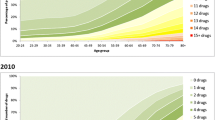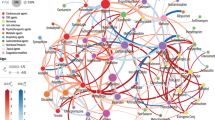Abstract
Objective
The widespread use of pharmaceuticals prescribed by different physicians has caused the Swedish government to propose a new legislation with registration of all prescriptions dispensed at the Swedish pharmacies. In the present study, we wanted to examine the frequency, distribution and determinants of potential drug interactions.
Methods
The prescriptions from all individuals (n=8,214) with two or more prescriptions during October 2003 to December 2004 were collected from the ongoing Jämtland cohort study of a total of about 11,000 individuals. Potential drug–drug interactions were detected with a computerized interaction detection system and classified according to clinical relevance (types A–D).
Results
On average each individual filled 14.6 (men 14.3, women 14.8) prescriptions during the study period. 3.6% of the individuals used more than 15 different drugs. The number of detected potential drug interactions type A–D was 4,941 (men 1,949, women 2,992). The risk of receiving a potential interaction type A–D was estimated as the cumulative incidence 0.26 (2,116/8,214) overall, 0.22 (748/3,467) for men and 0.29 (1,368/4,747) for women during the 15-month study period. The age adjusted risk, RRadj, for women was estimated as 1.30. Excluding sex hormones and modulators of the genital system, the RRadj was 0.96, with no elevated risk for women. For potential interactions type D, that might have serious clinical consequences, 167 (cumulative incidence 0.0203) individuals (72 men, cumulative incidence 0.0208, 95 women cumulative incidence 0.0200) were detected. The risk of receiving a combination of potentially interacting drugs was positively correlated to age and polypharmacy. The cumulative incidence for elderly was estimated as 0.36 (65–84 years) and 0.39 (85 years and above). The relative risk for individuals with 15 drugs or more was estimated as 3.67 (95% CI 3.46–3.90).
Conclusion
In a general population there were relatively few severe potential drug interactions. The new Swedish national pharmacy register will provide health care professionals with a powerful tool to systematically review all prescriptions. An alert system should focus on the more potential drug interactions, type C–D, with close monitoring of elderly and patients with polypharmacy.


Similar content being viewed by others
References
Prop. 2004/05:70 Ökad patientsäkerhet på läkemedelsområdet (Improved patient safety within the pharmaceutical arena). Socialdepartementet (Swedish Ministry of Health and Social Affairs), http://www.regeringen.se/sb/d/108/a/38890 2004-07-01
Bergendal L, Friberg A, Schaffrath A (1995) Potential drug-drug interactions in 5,125 mostly elderly out-patients in Gothenburg, Sweden. Pharm World Sci 17:152–157
Bjerrum L, Andersen M, Petersen G, Kragstrup J (2003) Exposure to potential drug interactions in primary health care. Scand J Prim Health Care 21:153–158
Bjorkman IK, Fastbom J, Schmidt IK, Bernsten CB (2002) Drug-drug interactions in the elderly. Ann Pharmacother 36:1675–1681
Boethius G, Wiman F (1977) Recording of drug prescriptions in the county of Jamtland, Sweden. I. Methodological aspects. Eur J Clin Pharmacol 12:31–35
Cadieux RJ (1989) Drug interactions in the elderly. How multiple drug use increases risk exponentially. Postgrad Med 86:179–186
Chen YF, Avery AJ, Neil KE, Johnson C, Dewey ME, Stockley IH (2005) Incidence and possible causes of prescribing potentially hazardous/contraindicated drug combinations in general practice. Drug Saf 28:67–80
Costa AJ (1991) Potential drug interactions in an ambulatory geriatric population. Fam Pract 8:234–236
Doucet J, Chassagne P, Trivalle C, Landrin I, Pauty MD, Kadri N, Menard JF, Bercoff E (1996) Drug-drug interactions related to hospital admissions in older adults: a prospective study of 1000 patients. J Am Geriatr Soc 44:944–948
Egger SS, Drewe J, Schlienger RG (2003) Potential drug-drug interactions in the medication of medical patients at hospital discharge. Eur J Clin Pharmacol 58:773–778
Goldberg RM, Mabee J, Chan L, Wong S (1996) Drug-drug and drug-disease interactions in the ED: analysis of a high-risk population. Am J Emerg Med 14:447–450
Gugler R, Allgayer H (1990) Effects of antacids on the clinical pharmacokinetics of drugs. An update. Clin Pharmacokinet 18:210–219
Hansten PD (2003) Drug interaction management. Pharm World Sci 25:94–97
Hardman JG, Limbird LE (2001) Goodman&Gilman’s The Pharmacological Basis of Therapeutics 10th International edn. McGraw-Hill Professional, New York, pp 54–56
Haumschild MJ, Ward ES, Bishop JM, Haumschild MS (1987) Pharmacy-based computer system for monitoring and reporting drug interactions. Am J Hosp Pharm 44:345–348
Henry D, Dobson A, Turner C (1993) Variability in the risk of major gastrointestinal complications from nonaspirin nonsteroidal anti-inflammatory drugs. Gastroenterology 105:1078–1088
Jankel CA, Fitterman LK (1993) Epidemiology of drug-drug interactions as a cause of hospital admissions. Drug Saf 9:51–59
Juurlink DN, Mamdani M, Kopp A, Laupacis A, Redelmeier DA (2003) Drug-drug interactions among elderly patients hospitalized for drug toxicity. Jama 289:1652–1658
Koch-Weser J, Greenblatt DJ (1977) Drug interactions in clinical perspective. Eur J Clin Pharmacol 11:405–408
Kohler GI, Bode-Boger SM, Busse R, Hoopmann M, Welte T, Boger RH (2000) Drug-drug interactions in medical patients: effects of in-hospital treatment and relation to multiple drug use. Int J Clin Pharmacol Ther 38:504–513
Kurfees JF, Dotson RL (1987) Drug interactions in the elderly. J Fam Pract 25:477–488
Linnarsson R (1993) Drug interactions in primary health care. A retrospective database study and its implications for the design of a computerized decision support system. Scand J Prim Health Care 11:181–186
Lipton HL, Bero LA, Bird JA, McPhee SJ (1992) The impact of clinical pharmacists′ consultations on physicians’ geriatric drug prescribing. A randomized controlled trial. Med Care 30:646–658
Manchon ND, Bercoff E, Lemarchand P, Chassagne P, Senant J, Bourreille J (1989) [Incidence and severity of drug interactions in the elderly: a prospective study of 639 patients]. Rev Med Interne 10:521–525
Merlo J, Liedholm H, Lindblad U, Bjorck-Linne A, Falt J, Lindberg G, Melander A (2001) Prescriptions with potential drug interactions dispensed at Swedish pharmacies in January 1999: cross sectional study. Bmj 323:427–428
Molden E, Garcia BH, Braathen P, Eggen AE (2005) Co-prescription of cytochrome P450 2D6/3A4 inhibitor-substrate pairs in clinical practice. A retrospective analysis of data from Norwegian primary pharmacies. Eur J Clin Pharmacol 61:119–125
Morera T, Gervasini G, Carrillo JA, Benitez J (2004) Early detection of drug interactions utilizing a computerized drug prescription handling system-focus on cerivastatin-gemfibrozil. Eur J Clin Pharmacol 59:917–921
Morera T, Gervasini G, Carrillo JA, Benitez J (2004) Using a computerized drug prescription screening system to trace drug interactions in an outpatient setting. Ann Pharmacother 38:1301–1306
Quinn D (1997) Clinically Important Drug Interactions. In: Speight TM, Holford N.H. (ed) Avery’s Drug Treatment, 4th edn. ADIS International, Auckland, Philadelphia, pp 301–328
Rosholm JU, Bjerrum L, Hallas J, Worm J, Gram LF (1998) Polypharmacy and the risk of drug-drug interactions among Danish elderly. A prescription database study. Dan Med Bull 45:210–213
Rothman KJ (1986) Modern Epidemiology. Little, Brown, Boston, Toronto, p 37
Rupp MT, DeYoung M, Schondelmeyer SW (1992) Prescribing problems and pharmacist interventions in community practice. Med Care 30:926–940
Seymour RM, Routledge PA (1998) Important drug-drug interactions in the elderly. Drugs Aging 12:485–494
Sjöqvist F (1997) Fundamentals of Clinical Pharmacology. In: Speight TM, Holford N.H. (ed) Avery’s Drug treatment, 4th edn. ADIS International, Auckland, Philadelphia, pp 52–53
Sjöqvist F (1997) A new classification system of drug interactions. Eur J Clin Pharmacol 52 (suppl.) Abstract 377
Stockley IH (2002) Stockley’s Drug Interactions, 6 edn. The Pharmaceutical Press, London, p 1
Strom BL (1994) Adverse reactions to over-the-counter analgesics taken for therapeutic purposes. Jama 272:1866–1867
Tatro DS, Olin BR (1992) Drug Interaction Facts. Facts and Comparisons, 3rd edn. Lippincott, St Louis
W.H.O. ATC Index. W.H.O. (2005) Collaborating Centre for Drug Statistics Methodology, http://www.whocc.no/atcddd/ 07–20
Vestal RE, Norris AH, Tobin JD, Cohen BH, Shock NW, Andres R (1975) Antipyrine metabolism in man: influence of age, alcohol, caffeine, and smoking. Clin Pharmacol Ther 18:425–432
Whitcomb DC, Block GD (1994) Association of acetaminophen hepatotoxicity with fasting and ethanol use. Jama 272:1845–1850
Zhan C, Correa-de-Araujo R, Bierman AS, Sangl J, Miller MR, Wickizer SW, Stryer D (2005) Suboptimal prescribing in elderly outpatients: potentially harmful drug-drug and drug-disease combinations. J Am Geriatr Soc 53:262–267
Acknowledgements
We are indebted to Sten-Erik Öhlund for developing the interaction detection software, to Mats Nordlöf for construction of Figs. 1 and 2 and to Apoteket AB for providing the crude data from the Jämtland study. The study was supported financially by Apoteket AB, including support to the E-Health Institute.
Author information
Authors and Affiliations
Corresponding author
Rights and permissions
About this article
Cite this article
Åstrand, B., Åstrand, E., Antonov, K. et al. Detection of potential drug interactions – a model for a national pharmacy register. Eur J Clin Pharmacol 62, 749–756 (2006). https://doi.org/10.1007/s00228-006-0143-x
Received:
Accepted:
Published:
Issue Date:
DOI: https://doi.org/10.1007/s00228-006-0143-x




